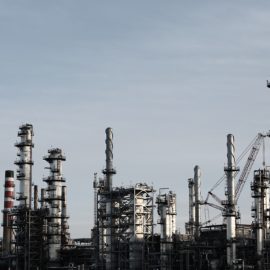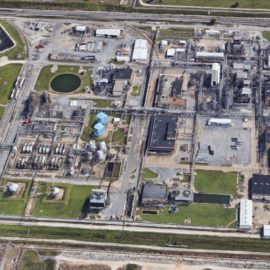
https://en.wikipedia.org/wiki/Denka_(company)
The EPA has faulted the LDEQ for not protecting the Black residents living near the Denka plant. This is not new news but rather a conformation of what we knew already.
The Environmental Protection Agency has found evidence that two state agencies charged with protecting public health – the Louisiana Department of Environmental Quality (LDEQ) and the Louisiana Department of Health (LDH) – have left Black residents living near the Denka facility in St. John the Baptist Parish, along with those living throughout the industrial corridor, disproportionately vulnerable to harmful pollutants, according to a letter the federal agency sent Wednesday. “Based on facts discovered thus far during EPA’s investigation, EPA issues this Letter to present significant evidence suggesting that the Departments’ actions or inactions have resulted and continue to result in disparate adverse impacts on Black residents of St. John the Baptist Parish, St. James Parish, and the Industrial Corridor,” Lilian Dorka, deputy assistant administrator for External Civil Rights at the EPA said in the letter addressed to LDEQ and LDH. The EPA is conducting an ongoing investigation, in part, under Title VI of the Civil Rights Act of 1964, into complaints the agencies discriminated on the basis of race against Black residents living in the region. The comments in Wednesday’s letter reflect the EPA’s initial investigation into the complaints.
thelensnola.org
Air pollution that causes cancer is one of the actions the state failed in.
One of those complaints, 01R-22-R6, alleges the LDEQ discriminated against Black residents by failing to pursue certain actions regarding the Denka Performance Elastomer LLC site – the only neoprene-producing facility in the United States – which resulted in disproportionate exposure to air pollutants like chloroprene, which the EPA classified as a likely human carcinogen in 2010. It seems that LDEQ’s actions and decisions have caused the majority-Black population living near the Denka facility to suffer adverse health impacts at disproportionate rates, according to the letter. “For decades, it appears that LDEQ’s implementation of its air permitting program continuously exposed the residents who live near the Denka facility and the children who attend the St. John the Baptist Parish’s Fifth Ward Elementary School to average annual concentrations of chloroprene in ambient air at levels associated with increased lifetime cancer risk,” Dorka wrote. Meanwhile, the EPA’s initial investigation shows that LDH may have failed to provide those residents with timely, critical information about the cancer risks associated with living near the Denka facility, given the exposure to chloroprene, Dorka said in the letter. The EPA’s recommended maximum annual average air standard for chloroprene is set at 0.2 micrograms per cubic meter of air – which amounts to a 100-in-1-million cancer risk. But chloroprene levels, according to EPA data, remained as high as 23.677 micrograms per cubic meter of air in St. John the Baptist Parish as of September 2021, the legal nonprofit Earthjustice said in its complaint in January on behalf of the groups Concerned Citizens of St. John and Sierra Club. Meanwhile, the EPA recorded extraordinarily high levels of chloroprene concentrations during a May visit, as documented in one-of-two reports the agency released last week, first reported by The Times-Picayune. One of those readings in the Denka plant extended beyond 240,000 micrograms per cubic meter.
The second charge deals with the permits issued. Definitely pro Denka.
In response to a second complaint, 04R-22-R6, (in which the Tulane Environmental Law Clinic alleged, among other things, that LDEQ’s decision to reaffirm the issuance of 14 air permits in August 2021 to FG LA LLC, which is part of the Taiwan-based Formosa Plastics Group, constituted a Title VI violation), the EPA said there’s evidence that Black residents throughout the industrial corridor have suffered from air pollutants at disproportionate rates. A state judge, meanwhile, vacated Formosa’s permits in a ruling last month, after determining that LDEQ violated both the federal Clean Air Act and its public trustee responsibilities, established in the Louisiana Constitution, in issuing them. “This is a powerful letter that holds LDEQ accountable for ignoring evidence that Black neighborhoods are overburdened with industrial pollution,” Lisa Jordan, director of the Tulane Environmental Law Clinic, told The Lens on Wednesday. “EPA’s actions over the next few months will be important, especially for neighborhoods like Wallace and Romeville, where recent LDEQ decisions have worsened the situation,” Jordan said, referring, in part, to the proposed grain elevator project that Greenfield Louisiana LLC, a Colorado-based company, is seeking to construct in Wallace. “Our clients look forward to working with EPA to ensure that any Informal Resolution Agreement or preliminary findings address all the LDEQ discriminatory air permitting practices identified in our complaint.” LDEQ declined to comment regarding the EPA’s letter. LDH did not respond to a request for comment, made late in the day on Wednesday, in time for this article’s publication.
The EPA has released reports showing the effect of the states lack of oversight.
The EPA’s letter comes in the wake of the agency’s publicly releasing two reports last week that, among other things, documented extraordinarily high levels of chloroprene on Denka’s property during this spring. In one of those reports, the result of a surprise visit the EPA conducted on May 5, 2022, the agency documented chloroprene concentrations at 243,000 micrograms per cubic meter inside the plant and up to 10,200 micrograms per cubic meter in the outdoor air, according to a report the EPA released last week. Gregory Langley, spokesman for LDEQ, said that reading, by itself, is not necessarily important. “It’s like sticking a meter sensor up inside the nozzle of a gas pump. You get high readings,” he said. “A few feet away, the readings [drop] sharply.” For its part, Denka has pointed to, among other things, the relative reduction in chloroprene levels it has achieved over the years (which environmental groups insist is still way too high). Denka “has invested over $35 million to reduce chloroprene emissions by 85 percent since assuming operation of its Neoprene facility near Reserve in St. John the Baptist Parish, and continuous ambient air monitoring conducted around the facility fenceline confirm similar reductions of chloroprene,” Jim Harris, spokesperson for Denka Performance Elastomer, told The Lens on Monday.
The EPA paid a surprise visit to the plant and the River Birch dump site.
In a separate report the EPA wrote pertaining to a surprise visit in April, the agency documented numerous areas of concern, including the fact that Denka sent more than 4.2 million pounds of waste neoprene off-site as a nonhazardous waste for disposal from 2019 through 2021. The waste – which Denka has recently sent to River Birch, a Subtitle D landfill in Jefferson Parish that isn’t equipped to handle hazardous material – may, in fact, be a “characteristic hazardous waste,” the EPA said. River Birch did not violate Resource Conservation and Recovery Act requirements in its handling of the waste neoprene, a spokesperson for River Birch told The Lens on Monday. “It should be noted that in the 2400 page document issued by the EPA, River Birch was mentioned twice. We have and will continue to follow all established permit conditions and rules in these matters.” LDEQ performed inspections of the Denka facility in 2017, 2019 and 2021, but didn’t publicly document any of the concerns raised by the EPA. “Most of the concerns you mention are inside the fence line – subject to [Occupational Safety and Health Administration] oversight,” Langley said when asked why the agency hadn’t documented them. “LDEQ was aware of the concerns,” he said.
OSHA is also looking at the plant.
OSHA is conducting an ongoing investigation into the Denka facility, Chauntra Rideaux, a public affairs representative in the U.S. Department of Labor, which houses OSHA, told The Lens. The EPA also documented the use of an outside brine pit that stores waste. While approaching the edge of the outside brine pit, the EPA inspectors’ photoionization detectors readings (used for ambient air analysis) persuaded them to exit the area abruptly. The EPA inspectors wore full-face respirators while in the vicinity of the outside brine pit, while the Denka employees were wearing none. The inspectors were not able to approach the outside brine pit again for closer monitoring due to the high levels of volatile organic compounds, according to the report. The outside brine pit could help explain why researchers at Louisiana State University encountered elevated levels of chloroprene near the Denka facility during a time when the plant’s production of chloroprene and neoprene were halted due to Hurricane Ida, Adrienne Katner, associate professor of environmental and occupational health sciences at LSU Health New Orleans School of Public Health, told The Lens. On September 23, 2021, for example, chloroprene levels at or across the street from the Fifth Ward Elementary School were 0.85 micrograms per cubic meter, according to the report, which is more than four times the EPA’s recommended level. The outside brine pit “would explain why we found chloroprene off site above the EPA recommended level,” she said, adding that she cannot think of another explanation that would account for the increased levels.
Thank you, Pastor Manning, for sending this to me. The River Birch dump has been the subject of an article posted as has this matter. This state and the parishes need to look at their residents not industry. The Jobs, Jobs, Jobs argument only goes so far when you look at the heath damage done.



